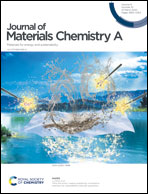Defect repair of tin selenide photocathode via in situ selenization: enhanced photoelectrochemical performance and environmental stability†
Abstract
Selenide with a narrow band gap can be used as a promising photoelectrode in photoelectrochemical (PEC) water splitting. However, the applications of selenides in high-performance PEC devices are greatly hindered via inducing oxygen into the lattice and generating high-density defects, which result in their environmental instability and high recombination of charge carriers. Here, we have used an in situ selenization strategy to repair the defects of a tin selenide (SnSe) film. The repaired SnSe film under an optimal selenization time shows a remarkable increase in both the limiting photocurrent density and environmental stability by over 3 times in comparison with the pristine film. On the basis of the analysis of the composition and structure, Se element filling in the defects during selenization is critical for suppressing the recombination of charge carriers and reducing the possibility of oxygen bonding to Sn in the bulk of the film. Such strategy can greatly provide a fundamental and technological support in the development of selenide-based devices and enrich the knowledge of defect chemistry for PEC applications.



 Please wait while we load your content...
Please wait while we load your content...